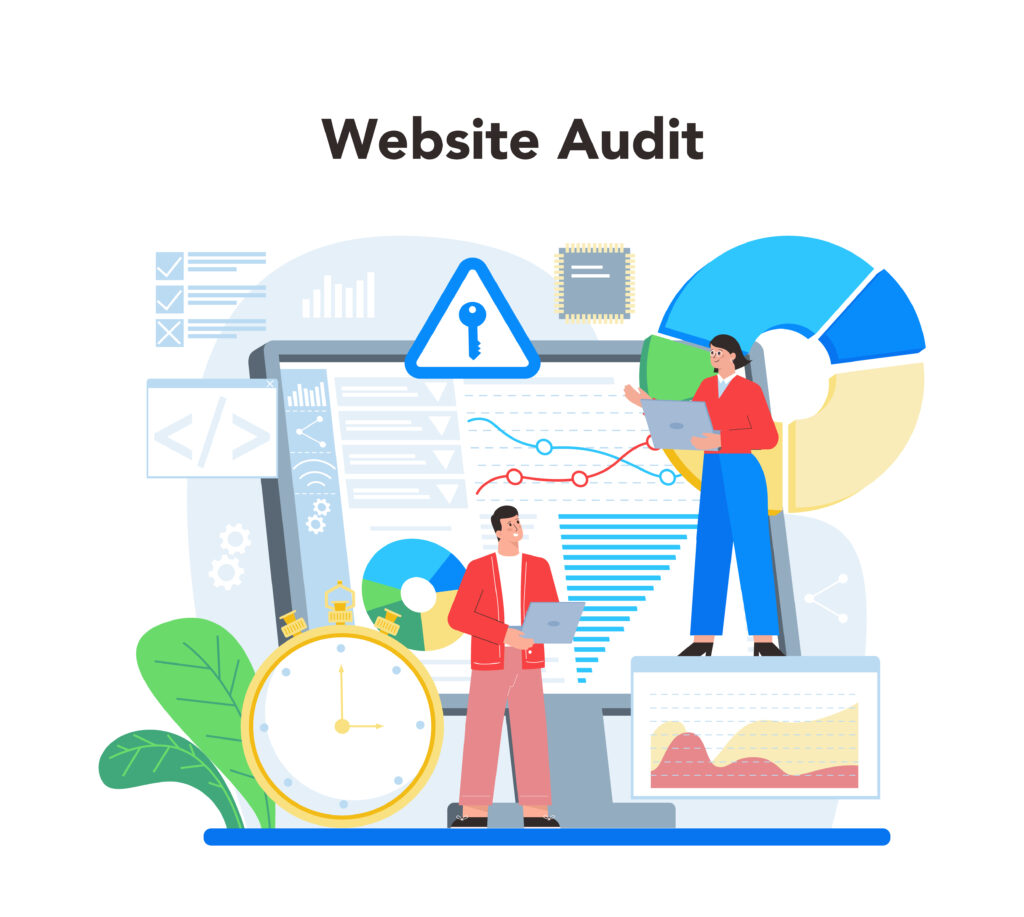In today’s digital landscape, search engine optimization (SEO) plays a crucial role in the success of any online business. Conducting regular SEO audits is a fundamental step in improving your website’s visibility and ranking on search engine results pages (SERPs). By thoroughly assessing your website’s performance, identifying areas of improvement, and implementing the necessary changes, you can optimize your online presence and attract more organic traffic. In this article, we will discuss the process of conducting an effective SEO audit and provide you with a comprehensive checklist to guide you through the audit process.
Table of Contents
- Introduction
- Understanding the Importance of SEO Audits
- Setting Clear Goals and Objectives
- Conducting Keyword Research and Analysis
- Assessing On-Page Optimization Factors
- Evaluating Website Structure and Navigation
- Analyzing Backlink Profile
- Reviewing Technical SEO Elements
- Monitoring Website Performance and User Experience
- Tracking Mobile Compatibility
- Checking for Duplicate Content
- Optimizing Site Speed and Performance
- Assessing Social Media Integration
- Ensuring Proper Indexing and Crawling
- Measuring Analytics and Tracking Progress
- Conclusion
- Discover ” SEO 2021: Actionable, Hands-on SEO, Including a Full Site Audit (Webmaster Series)” Book
- FAQs (Frequently Asked Questions)
1. Introduction
In this digital age, having a strong online presence is vital for businesses to thrive. An effective SEO audit helps you evaluate your website’s performance, identify areas that need improvement, and devise strategies to enhance your search engine visibility.

2. Understanding the Importance of SEO Audits
SEO audits serve as a diagnostic tool to assess the overall health of your website in terms of SEO. By conducting regular audits, you gain insights into factors affecting your website’s ranking and visibility, allowing you to make informed decisions for optimization.
3. Setting Clear Goals and Objectives
Before conducting an SEO audit, it’s crucial to define your goals and objectives. Are you aiming to increase organic traffic, improve conversion rates, or enhance user experience? Clear goals will help you focus your audit efforts and measure success accurately.
4. Conducting Keyword Research and Analysis
Keyword research is a foundational step in SEO audits. Identify relevant keywords and phrases that your target audience is likely to search for. Utilize keyword research tools to analyze search volumes, competition levels, and identify high-potential keywords to optimize your content.
5. Assessing On-Page Optimization Factors
On-page optimization is essential for search engine visibility. Evaluate elements such as meta tags, headings, keyword usage, and content quality. Ensure your content is well-structured, engaging, and relevant to both users and search engines.
6. Evaluating Website Structure and Navigation
A well-organized website structure and intuitive navigation enhance user experience and improve search engine crawlability. Assess your website’s architecture, URL structure, internal linking, and navigation menus to ensure easy accessibility for both users and search engines.
7. Analyzing Backlink Profile
Backlinks are crucial for SEO success. Analyze your website’s backlink profile, assessing the quality, relevance, and diversity of your incoming links. Identify any toxic or low-quality links that may be negatively impacting your rankings.
8. Reviewing Technical SEO Elements
Technical SEO focuses on website performance and optimization from a technical standpoint. Evaluate factors such as website speed, mobile responsiveness, XML sitemaps, robots.txt files, and structured data markup. Fix any technical issues that may hinder your website’s performance.
9. Monitoring Website Performance and User Experience
An effective SEO audit should consider user experience and overall website performance. Evaluate page loading times, website responsiveness across different devices, and user engagement metrics. Address any issues that may impact user experience and hinder conversions.
10. Tracking Mobile Compatibility
With the increasing use of mobile devices, optimizing your website for mobile compatibility is essential. Ensure your website is responsive, loads quickly on mobile devices, and provides a seamless user experience across various screen sizes.
11. Checking for Duplicate Content
Duplicate content can harm your search engine rankings. Conduct a thorough analysis to identify any duplicate content issues within your website or across the web. Use canonical tags or implement necessary measures to address duplication problems.
12. Optimizing Site Speed and Performance
Website speed is a critical ranking factor. Optimize your website’s loading times by compressing images, minifying CSS and JavaScript files, and leveraging caching techniques. A fast-loading website improves user experience and encourages longer visit durations.
13. Assessing Social Media Integration
Social media integration can amplify your online presence and increase brand visibility. Evaluate your social media profiles and their integration with your website. Implement social sharing buttons and encourage social engagement to enhance your SEO efforts.
14. Ensuring Proper Indexing and Crawling
Search engines need to crawl and index your website effectively. Check for crawl errors, ensure the accessibility of important pages, and utilize XML sitemaps to guide search engine crawlers. Monitor and manage your website’s indexing status regularly.
15. Measuring Analytics and Tracking Progress
Implement robust analytics tracking to monitor your website’s performance and track the effectiveness of your SEO strategies. Utilize tools like Google Analytics to measure organic traffic, conversions, bounce rates, and other key performance indicators.
Read More: Dominating Local Search with Local SEO
Discover ” SEO 2021: Actionable, Hands-on SEO, Including a Full Site Audit (Webmaster Series)” Book

Do you want to learn a safe & effective SEO strategy that works in 2021? Real search engine optimization where you build 100% white-hat backlinks to catapult your site to the top of the SERPs? An SEO plan without risk of a Google slap or penalty?
In 2021, how many SEO books & courses can offer that type of search engine optimization? This book can!
Google is on the SEO warpath. Anyone caught breaking the rules or trying to manipulate rankings through aggressive SEO techniques, will find their website dropping out of the top 10, top 100, or out of the search results altogether. Commonly taught SEO techniques can now kill your rankings!
Google released a whole menagerie of animals (Panda, Penguin, Pigeon, etc),
but also employs humans to rate your content. You cannot fly under the radar any more. Gone are the days of fast rankings with SEO loopholes. Today, SEO can be dangerous if you follow the wrong advice. Most free online SEO advice is very wrong because it’s either out of date, or written by someone that doesn’t do it for a living. I’ve been studying, testing, and teaching SEO for over a decade.
SEO 2021 is a book that will teach you the safe, white-hat search engine optimization strategies I personally use to get my web pages (and those of my clients) to rank high in Google. This is battle-tested, white hat SEO that I’ve learned, developed and tested over the last decade. On-site optimization techniques that I was teaching my newsletter readers back in 2008, are only now becoming mainstream in SEO. I play by Google’s rules, meaning I never have to wake up after a major update and wonder if my sites have been hit.
With so many algorithm changes taking place at Google, you might be wondering how it is possible to stay up to date with all the changes. The good news is that it is easy once you acquire the right mindset. Understand what Google is trying to do, and give it to them. You won’t find me discussing loopholes or strategies to beat the system. What you will find is solid strategies & advice to create great content, build authority links, and increase your domain authority.
This book covers everything you need to know, including:
- What is SEO and what are the main rnaking factors?
- Major Google changes and how they have affected the way we do SEO.
- Creating the quality content your visitors want, and search engines love.
- Finding essential theme words and phrases for any piece of content you write.
- All on-page factors discussed.
- Scema & Structured data.
- Site organization & structure.
- What is authority, and how you can you incrase yours?
- How to get authority, white-hat, high quality backlinks.
- Giving your visitors what they want, while keeping search engines happy.
- A complete SEO audit to check for common problems.
SEO 2021 was written by search engine veteran Andy Williams of ezSEONews.com. He has been teaching this stuff since 2003, in his free weekly newsletter. If you want to understand what the search engines want, and learn modern search engine optimization that gets higher rankings through great content and smart backlinking, explode your traffic, AND have Google’s blessing, then you should read this book.
Conclusion
Conducting an effective SEO audit is crucial for optimizing your website’s visibility, attracting organic traffic, and achieving online success. By following the outlined steps and utilizing the provided checklist, you can identify areas of improvement and implement effective strategies to enhance your SEO efforts.
FAQs (Frequently Asked Questions)
A good SEO audit involves a comprehensive evaluation of various factors, including keyword research, on-page optimization, website structure, backlink profile, technical SEO elements, user experience, and analytics tracking. It should provide actionable insights to improve search engine visibility and organic traffic.
An SEO audit checklist is a tool that guides you through the process of conducting an SEO audit. It includes a list of essential elements to evaluate, such as keyword research, on-page optimization, website structure, backlink profile, technical SEO, user experience, and analytics tracking. It ensures that no critical aspect of SEO is overlooked during the audit process.




